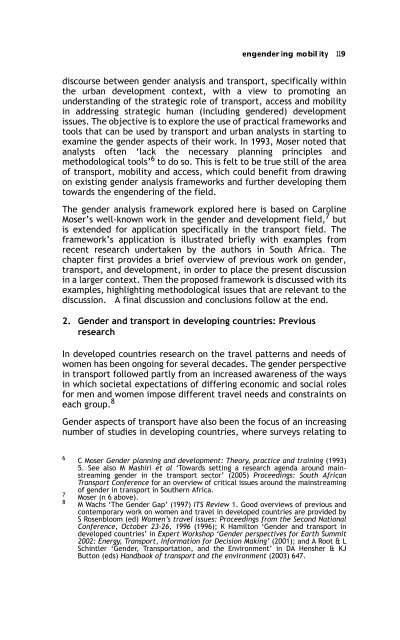Sex, Gender, Becoming - PULP
Sex, Gender, Becoming - PULP
Sex, Gender, Becoming - PULP
You also want an ePaper? Increase the reach of your titles
YUMPU automatically turns print PDFs into web optimized ePapers that Google loves.
engendering mobility 119<br />
discourse between gender analysis and transport, specifically within<br />
the urban development context, with a view to promoting an<br />
understanding of the strategic role of transport, access and mobility<br />
in addressing strategic human (including gendered) development<br />
issues. The objective is to explore the use of practical frameworks and<br />
tools that can be used by transport and urban analysts in starting to<br />
examine the gender aspects of their work. In 1993, Moser noted that<br />
analysts often ‘lack the necessary planning principles and<br />
methodological tools’ 6 to do so. This is felt to be true still of the area<br />
of transport, mobility and access, which could benefit from drawing<br />
on existing gender analysis frameworks and further developing them<br />
towards the engendering of the field.<br />
The gender analysis framework explored here is based on Caroline<br />
Moser’s well-known work in the gender and development field, 7 but<br />
is extended for application specifically in the transport field. The<br />
framework’s application is illustrated briefly with examples from<br />
recent research undertaken by the authors in South Africa. The<br />
chapter first provides a brief overview of previous work on gender,<br />
transport, and development, in order to place the present discussion<br />
in a larger context. Then the proposed framework is discussed with its<br />
examples, highlighting methodological issues that are relevant to the<br />
discussion. A final discussion and conclusions follow at the end.<br />
2. <strong>Gender</strong> and transport in developing countries: Previous<br />
research<br />
In developed countries research on the travel patterns and needs of<br />
women has been ongoing for several decades. The gender perspective<br />
in transport followed partly from an increased awareness of the ways<br />
in which societal expectations of differing economic and social roles<br />
for men and women impose different travel needs and constraints on<br />
each group. 8<br />
<strong>Gender</strong> aspects of transport have also been the focus of an increasing<br />
number of studies in developing countries, where surveys relating to<br />
6<br />
C Moser <strong>Gender</strong> planning and development: Theory, practice and training (1993)<br />
5. See also M Mashiri et al ‘Towards setting a research agenda around mainstreaming<br />
gender in the transport sector’ (2005) Proceedings: South African<br />
Transport Conference for an overview of critical issues around the mainstreaming<br />
of gender in transport in Southern Africa.<br />
7 Moser (n 6 above).<br />
8<br />
M Wachs ‘The <strong>Gender</strong> Gap’ (1997) ITS Review 1. Good overviews of previous and<br />
contemporary work on women and travel in developed countries are provided by<br />
S Rosenbloom (ed) Women’s travel issues: Proceedings from the Second National<br />
Conference, October 23-26, 1996 (1996); K Hamilton ‘<strong>Gender</strong> and transport in<br />
developed countries’ in Expert Workshop ‘<strong>Gender</strong> perspectives for Earth Summit<br />
2002: Energy, Transport, Information for Decision Making’ (2001); and A Root & L<br />
Schintler ‘<strong>Gender</strong>, Transportation, and the Environment’ in DA Hensher & KJ<br />
Button (eds) Handbook of transport and the environment (2003) 647.
















